Chord Theory Part 5 - Chord Voicings
In guitar chord theory part 4 we looked at extended chords which brought us nicely to the end of the core elements of chord construction.Now it's time to focus on how to construct alternate voicings of those same chords, using your chord and fretboard knowledge. This will allow you to experiment with a wider choice of chord harmonies, giving you options outside the same old barre and open chord forms.
 Free chord
cheat sheet Free chord
cheat sheetLearn how guitar chords work together in any key... Click here to start now |
What do I mean by "voicing"?
A voicing is a particular expression of a given chord, based on the order in which the tones are stacked. For example, playing E major in the open position is one voicing. Playing E major using an A form barre chord at the 7th fret is another voicing of that same chord. Both offer different expressions of the same chord.
Think of it like repeating something you have just said, but using different words. The meaning is the same, but the expression is different.
Each chord voicing is unique because of the order of tones from the low to high strings in the chord shape (e.g. R 3 5 vs R 5 3).
Knowing several voicings of the same chord gives you several options when writing a chord progression. Instead of relying on one chord position, and therefore one voicing, you'll notice that connecting certain alternate chord voicings in different positions creates more meaningful, intricate harmonies through the progression.So, quite difficult to explain! The best way to understand is to play and hear it, so let's get to it...
13th chord voicings
In part 4 we looked at dominant 13th chords and how they consisted of the root, 3rd, 5th, minor 7th (b7), 9th and 13th.
So they are very full sounding chords as they stack up more than four notes.
Below are a some ways (voicings) you could play this 13th chord. The key thing is to play one after the other and hear the difference...
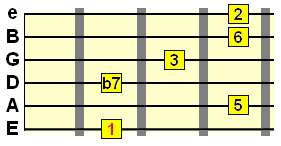
Now a different voicing of the same chord using the same root position...
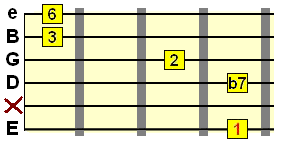
Although the same chord, both forms offer different expressions of the same chord because the order of tones is different (from low to high: 1 5 b7 3 6 2 vs 1 b7 2 3 6)
Now, comparing the two, the only difference is...
A lower voiced 2 (9th) in the second chord form.
But it gives it a different sound nevertheless. I actually prefer that lower sounding 9th, but this is where your creative side comes in - what do you want to hear? What sounds best as part of the chord progression you're playing/writing?
How does the voicing connect to the previous and next chords in the sequence?
Here's another 13th chord voicing (without the 5th), this time in the A string position (A string root note)...
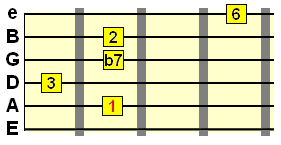
A voicing every funk player should know!
So again, same chord as the two before, but notice how the major 3rd is the second lowest note in this voicing, whereas in the other two it was voiced higher. This is enough to change its sound. It's subtle, but your ear will gradually become more sensitive to these differences.
Aside from the difference in sound, knowing several voicings for the same chord means you have several positions you can play that chord on the fretboard. This in turn means more economical finger movements - no more jumping from one end of the fretboard to the other!
Major 7th chord voicings
Back in part 3 we looked at 7th chords - four note chords and the first extensions of the basic major/minor triads.
If you followed that lesson, you'll know that a major 7th (maj7) chord includes all the chord tones stacked up to the major 7th - Root, 3rd, 5th and 7th.
So, let's look at a couple of different voicings for this chord...
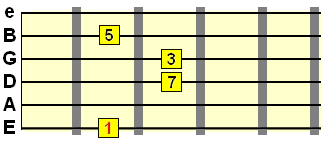
Standard E string root voicing there. But if you wanted a higher voicing, there is the option to build the chord on a D string root...
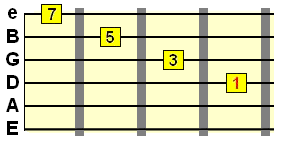
A very conveniently stepped pattern there - easy to memorise.
The 5th and 7th are higher in the second voicing.So, same chord, two very different voicings, and only you know which one will fit best in your song/chord progression.
Minor 'added 9th' chord voicings
We looked at "add" chords in part
4.
Basically, the number referenced in the chord name is
the highest tone used in the chord. But because
there is no 7th
in the chord, it
becomes an add chord. To summarise:
1, b3,
5,
b7,
9
= Minor 9th chord (e.g. Cm9, Dm9, Em9)
1, b3,
5,
9
= Minor added
9th chord - no 7th (e.g. Cmadd9, Dmadd9, Emadd9)
Let's look at a couple of voicings of this madd9 chord...
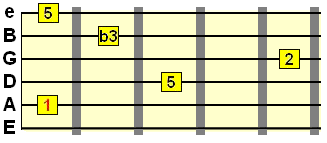
It's a bit awkward to get that added 9th in for those of us with smaller hands/fingers, so let's try a descending form on the same root position as an alternate voicing/fingering...
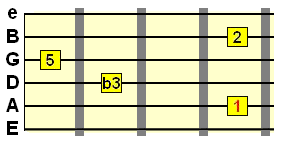
- Higher 5th in the second voicing.
- Lower minor 3rd (b3) in the second voicing (the b3 is what makes it minor).
- Easier to finger - here we see another benefit of learning multiple chord voicings. Some are physically easier to play than others!
We could also get a higher voicing of this chord by referring to a D string bass/root note...
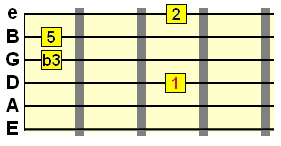
So if you took all three voicings and made sure the root note was the same for each one (e.g. D), you'd technically be playing the same chord (and they'd all be compatible with each other), yet they sound different. That's the beauty of chord voicing!
Building your own chord voicings
Use this process to find alternate chord voicings...1. Play the chord in a position/form you know (e.g. open position, barre chord etc.).
2. Identify the root note of the chord.
3. Find that same root note on the E, A and D strings, giving you three root positions.
4. Use your knowledge of the major scale's patterns on those root strings to build the same chord in different positions on those bass root notes.
5. Add/remove notes, sharpen/flatten notes and just have fun discovering new chords.
| Want to cheat?
Use this free Chord
Finder.
Click on the note on which your chord's root lies, and then the type of
chord you
want to build (e.g. "maj9") and then click "variations" to see
where it can be played. However, don't just learn it parrot fashion! Try and test your knowledge and see if you can find the variations without any help before you get the answers. |
As time goes on, you'll discover more interesting and unusual chords.
For example, what on earth is
this jazzy-bluesy chord (you can always trust jazz to
throw up unusual chords)?
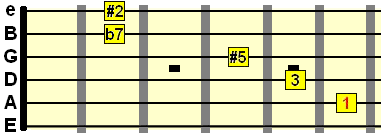
It's probably not what you thought - Ebaug7#9 (that's E flat augmented 7th sharp 9th) - what a mouthful! A big stretch for the fingers as well, so more accessible higher up the fretboard where the fret spacings are narrower.
Let's just try to deconstruct this to understand it more...
-
Root note is on Eb (A string, 6th fret).
-
The sharp 9th (or sharp 2nd) is actually in the same position as the minor 3rd would be, but because the chord consists of the root, 3rd and #5 (and augmented triad), the minor 3rd takes on the role of an extension tone - the sharp 9th. The b7 is also an extension of the augmented triad as we learned in an earlier part.
You should now be fairly confident about finding alternate chord voicings up and down the fretboard. Soon, if you really get to know the major scale patterns you'll be able to experiment like this without referring to a scale diagram.
You'll just see intervals in relation to a root note, whether it be a b3, #9 or b6.
You'll eventually know where the "6th/13th" lies in relation to the "5th" on more than one string.
Investigate the fretboard. Learning fretboard theory doesn't have to be dull!
We'll look at this in more depth in the next (and last) lesson for more advanced chord voicings and chord inversions, where the root isn't the lowest note in the chord!
| |
Tweet |
Sign up to the newsletter for updates and grab your free Uncommon Chords book
Related








